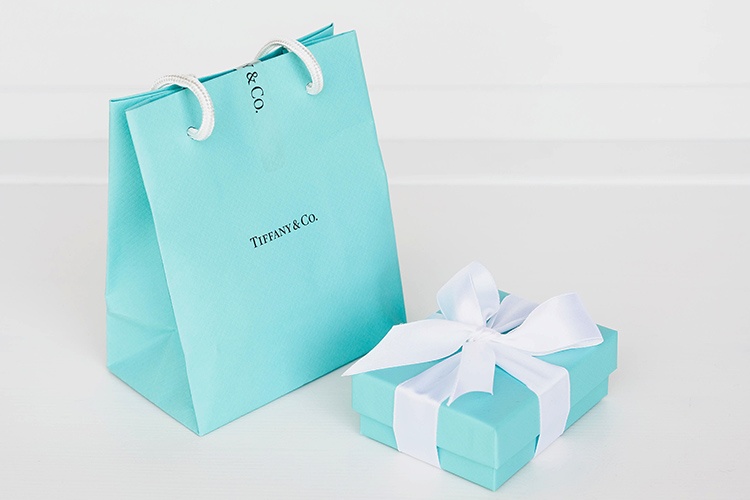Few things are as instantly recognizable as a box from Tiffany. The legendary jewelry company is known as much for its iconic jewelry designs as it is for those robin egg blue boxes with their white ribbons and simple black lettering.
Now a global brand with stores in every major city, Tiffany began as a New York store selling high-end stationery. In 1838, Charles Lewis Tiffany and John Young opened their store on Fifth Avenue in New York City under the name Tiffany & Young. When Charles’s son Louis Comfort Tiffany took over as the store’s artistic director, he shifted the emphasis to jewelry. Tiffany & Co. soon established itself as the leading retailer of luxury silver and diamond jewelry in the country.
The Tiffany Blue Book
In 1845, the store began publishing an annual catalog called the Tiffany Blue Book. This pale shade of blue booklet was the first direct mail catalog in US history. People all over the country could buy Tiffany’s luxury goods, including rings, watches, and rare gemstones.
The Blue Book is the first place the famous robin egg blue color — now officially known as Tiffany Blue — appeared. Tiffany still publishes the Blue Book every year, listing the world’s most exclusive jewels currently for sale.
Historic Firsts in Jewelry and Design
Tiffany has a history of being first and best when it comes to jewelry and design.
In 1886, Charles Lewis Tiffany introduced a diamond ring with a six-pronged setting and called it the Tiffany Setting. Today, this simple setting is considered the classic engagement ring design. Charles’s son Louis Comfort Tiffany also made history with his beautiful stained-glass lamps, now commonly referred to as Tiffany lamps.
Tiffany is also known for its trophy design. In 1967, the NFL commissioned Tiffany to design the Lombardi Trophy for the Super Bowl. Tiffany & Co. still makes this trophy annually, along with others like the NBA Finals trophy and the World Series trophy.
Breakfast at Tiffany’s
The iconic film Breakfast at Tiffany’s, based on Truman Capote’s novel, is one of the few movies filmed at the flagship store in New York. There was no restaurant at the time of filming, but in 2017, Tiffany opened the Blue Box Café, allowing customers to finally enjoy “breakfast at Tiffany’s” in the store.

The Blue Box
Charles Tiffany had an instinctive understanding of marketing. When he designed the store’s advertising materials, bags, and packaging, Tiffany used the same shade of blue featured in the Tiffany Blue Book. He also knew the bags would be in high demand.
He was right. People coveted the bags, but the store had a firm policy of only giving them out with a purchase. According to an article in the Jewellery Editor:
“It was Charles Lewis Tiffany who decreed that the boxes could only be procured with a Tiffany purchase, prompting the New York Times to report in 1906: ‘Tiffany has one thing in stock that you cannot buy off him for as much money as you may offer: He will only give it to you. And that is one of his boxes.” During the filming of Breakfast at Tiffany’s at the New York store, 40 armed guards were on hand to stop any of the blue boxes being pilfered.”
During the filming of Breakfast at Tiffany’s, 40 armed guards were stationed at the store to prevent anyone from pilfering the now-famous Tiffany Blue boxes.
Registering Tiffany Blue
Recognizing its significance, Tiffany sought trademark protection for its iconic color. In 1998, Tiffany officially filed for registration of Tiffany Blue as a color trademark with the US Patent and Trademark Office. The color is officially named Pantone Tiffany Blue 1837, a nod to the year the company was founded.
Much like Christian Louboutin’s red soles and T-Mobile’s magenta, Tiffany Blue is a prime example of a color trademark that has acquired secondary meaning in the market.
The ability to grant legal rights to a single shade of blue illustrates how powerful trademark protection can be when a color becomes strongly associated with a brand in the minds of the consumer.
Subtle Changes Only
The lettering on Tiffany boxes is also a custom typeface named ITC Tiffany, designed in 1974 by Ed Benguiat. Since its founding almost 200 years ago, Tiffany has made almost no changes to its branding or trademarks. In 2017, the company felt it no longer captured minds and hearts as a high-end brand. To change that, Tiffany embarked on a marketing and graphics overhaul.The company hired Pentagram and designer Paula Scher to modernize its visual identity while preserving its timeless elegance. Pentagram subtly refined the logo and packaging to give the boxes and bags a more luxurious feel. The redesign ensured Tiffany Blue remained a beacon of sophistication. As Pentagram described it:
“The designers achieved this by restoring the graphic luster of the brand, first refining the logotype and then establishing consistent application of the identity across packaging, advertising and other ephemera such as stationery, shopping bags, ribbons and corporate materials. Most important, the new standards focus on the most familiar and sought-after application of the Tiffany brand: the signature ‘little blue box.’ The designers have subtly redesigned the familiar blue packaging in a way that gives the bags and boxes a more luxurious feel.”
It was a subtle change that maintained the simple elegance associated with the name Tiffany.
Legal Battles
Like any iconic brand, Tiffany has had to sue others to defend its trademark protection.
Costco Case
Tiffany’s largest legal dispute was its lawsuit against Costco Wholesale. Costco sold diamond engagement rings marketed under the Tiffany name, arguing that “Tiffany setting” was a generic description for a six-prong ring design. A judge initially ruled in Tiffany’s favor, awarding the company $19.4 million in damages. The court criticized Costco for its cavalier use of the Tiffany name.
However, in August 2020, the 2nd US Circuit Court of Appeals overturned the ruling. The court agreed with Costco, stating that “Tiffany” was both a brand name and a widely recognized descriptive term for a particular style of ring.
This decision echoes the principles set in the Qualitex ruling, where the Supreme Court determined that a single color can be trademarked if it acquires secondary meaning — something Tiffany Blue has undoubtedly achieved.
This case also underscores the risk brands face when their trademarks become so popular that they get sued for their own widespread recognition.
Read more on well-known trademarked colors, as well as the process for trademarking a color.
eBay Counterfeit Case
In 2008, Tiffany also sued eBay, alleging the platform allowed sellers to market counterfeit Tiffany products. The court ruled in eBay’s favor, finding that it was primarily Tiffany’s responsibility to monitor trademark infringement.
Blue Skies Ahead
Despite occasional setbacks, Tiffany remains a dominant force in luxury retail. The company’s iconic Tiffany Blue, deeply tied to Victorian brides and timeless elegance, will undoubtedly continue as a symbol of beauty and prestige.
By rigorously defending its trademark protection, Tiffany ensures that its shade of blue remains synonymous with the brand. Whether through legal battles, carefully controlled use of its packaging, or subtle branding updates, Tiffany’s commitment to protecting its identity ensures its status as a leader in luxury.
For companies looking to trademark colors, Tiffany Blue and Christian Louboutin’s red soles serve as excellent examples of how to successfully use secondary meaning to build a strong, protected identity.

